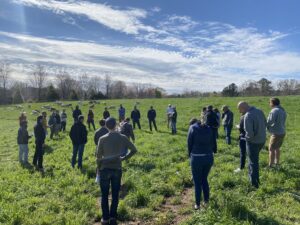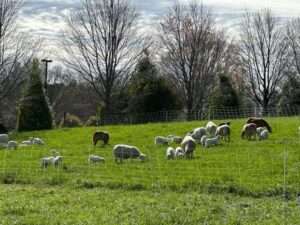Bringing industry professionals together: 2024 NABCEP Conference
The North American Board of Certified Energy Practitioners (NABCEP) Conference brings together many solar PV professionals each year and provides an array of opportunities for individuals to advance their careers.
On March 18, the 2024 conference began in full swing with an off-site training session provided by the training team at NC Clean Energy Technology Center (NCCETC) and NC State University’s Cooperative Extension as a pre-conference event. Focused on solar grazing, the session first brought students to an in-person tour of an active farm at NC State’s Small Ruminant Learning Lab, led by Dr. Andrew Weaver, Assistant Professor and Extension Specialist.

Dr. Weaver discussed the benefits of solar grazing, including weed control, maximizing land use, and creating a symbiotic relationship between renewable energy and agriculture.
Vegetation and weeds underneath solar panels can be controlled with the help of grazing animals, which is an eco-friendly alternative to methods such as herbicides and frequent mowing by gas or diesel-powered machinery. Solar grazing also maximizes land use efficiency, as the space beneath solar panels is used for multiple purposes. This practice creates a symbiotic relationship between renewable energy and agriculture, where the solar panels generate clean energy, and the grazing animals can enjoy the land and the shade provided by those panels. It is important to note that not all grazing animals can be used symbiotically in conjunction with solar panels, so the tour participants had an in-depth discussion about the benefits, care, and cooperation of sheep and sheep farmers on a solar site. The farmers benefit as well, generating additional income from their land by allowing these two processes to exist in harmony.

Not only does solar grazing allow for innovative renewable energy production, but it also brings communities together by involving local farmers, solar developers, and residents. Dr. Weaver describes solar farms as “hubs of collaboration, sustainability, and shared prosperity.”
After visiting the farm, the tour visited SAS’s solar farm which employs sheep for vegetation management. Zane Lichtneger, Sustainability Analyst, explained, “SAS only uses mowers in their solar farm roughly 2-3 times a year. That’s how well the sheep manage the grass here.”
Following the training, conference sessions began at the Raleigh Convention Center. The sessions covered many areas of industry topics, including installation techniques, energy storage solutions, insulation resistance testing, energy management, and more. To view a full list of conference sessions, click here. NABCEP also provided PV Associate Training onsite at the conference, allowing participants to earn the educational hours needed to sit for the PV Associate exam.
Conference attendees also heard from keynote speaker Steve Kalland, Executive Director of NCCETC. Kalland noted the center’s involvement with NABCEP training and testing, which has been ongoing since the board’s establishment in 2002. He then explained the four factors vital to making solar work in today’s world. These are: technology that works; policies that shape and open the market; the cost of technology compared to alternatives; and the public’s belief in the product.

Kalland said that the solar market has reached a turning point where the benefits of solar energy are known, but the questions are “‘how fast will solar happen, who will own it, and on what side of the meter?’” He described the importance of policy in cost discussions, and highlighted the DSIRE database that the center created in 1997 to establish a “comprehensive source of information on incentives and policies that support renewable energy, energy efficiency, energy storage, and EV infrastructure in the United States.” Kalland also spoke on a new federal incentive program, Solar for All, under the EPA, which gives low-income households and disadvantaged communities an opportunity to access solar energy and its benefits. The program is funded with $7 Billion, where 75% of the funds are required to go toward customer financial assistance.
Kalland emphasized the need for professionals to work together to ensure solar continues to be viewed positively in the current climate, “This is why organizations like NABCEP and SEIA are important. Support them and their goals and we will have an opportunity to continue to grow solar for everyone.”
The NABCEP conference succeeded in bringing solar PV professionals together to connect and to advance their knowledge of the industry. NCCETC continues to host training sessions for individuals who are interested in gaining experience in various aspects of renewable energy. The center will be launching a Solar Technical Sales course along with roundtable events for rooftop solar companies to give feedback about the best practices for solar installation within a federal project. If you would like to be involved in the conversation, contact the NCCETC Training Team at cleanenergy@ncsu.edu for more information.